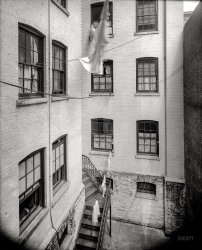
MAY CONTAIN NUTS

Search Shorpy
SHORPY ART

Framed or unframed, desk size to sofa size, printed by us in Arizona and Alabama since 2007. Explore now.
Join and Share
Ad-Free Shorpy
Shorpy is funded by you. Patreon contributors get an ad-free experience.
Learn more.

Recent comments
- Baldwin 62303
- Baldwin VO-1000
- Cold
- No expense spared
- Tough Guys
- Lost in Toyland
- And without gloves
- If I were a blindfolded time traveler
- Smoke Consumer Also Cooks
- Oh that stove!
- Possibly still there?
- What?!?
- $100 Reward
- Freeze Frame
- Texas Flyer wanted
- Just a Year Too Soon
- WWII -- Replacing men with women at the railroad crossing.
- Yes, Icing
- You kids drive me nuts!
- NOT An Easy Job
- I wonder
- Just add window boxes
- Icing Platform?
- Indiana Harbor Belt abides
- Freezing haze
- Corrections (for those who care)
- C&NW at Nelson
- Fallen Flags
- A dangerous job made worse
- Water Stop
Member Photos
The Shorpy
Print Emporium
Print Emporium
Search Shorpy
Search results -- 30 results per page
- Fine Groceries: 1905
- New York circa 1905. "Exterior of tenement house, E. 40th Street." Our fifth look at this building . 8x10 ... Posted by Dave - 08/02/2012 - 7:44pm -
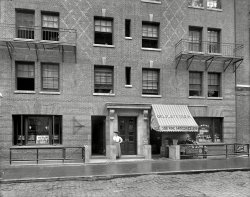
- Idlers: 1916
- ... some of his comments on alcohol in his various photos of tenement life, one wouldn't be surprised if he were a prohibitionist. Indeed a ... Posted by Dave - 10/01/2008 - 10:48am -
![Idlers: 1916 June 29, 1916. Chicopee Falls, Massachusetts. "Hanging around the saloon -- 5 p.m." Photograph by Lewis Wickes Hine. View full size.
Boys on the Stoop"Range in age from 18 to 65. After working 10-12 hours at mill, cannery and factory, repair to the saloon for alcoholic beverages at 5 o'clock on a Monday afternoon. All said they had been doing this since they were old enough to see over the bar. Most smoke. Whites sociliaze frequently here with Negroes and Italians."
I love these guys!They worked hard and they played hard. Stopping at the gin mill after work to "turn over a few" was a ritual and I well remember my uncle and his friends ending the workday with a drink or two and an (illegal) street game of shooting craps for pennies. The police would just tell them to go home and move on. Those "bucket of blood" saloons had signs in the window saying they had "tables for ladies" but no lady ever entered therein. Sometimes when the playful shoving and pushing got out of hand (i.e. that guy falling off the stoop) a real fist fight would break out, there would be blood, usually from noses, and the next thing being heard as someone was dragged away was "Did he have a hat?" A GREAT and unexpected scene from my childhood. Thank you for this unusual photo to bring it all back.
Outdoor TypesMy friends and I used to go inside.
Shake On It!Looks like the dapper young thing in the white shoes doesn't want to get his pants dirty, so he is sitting on a towel. Sort of out of place with this rough-and-tumble crowd. I notice their ale comes from Springfield -- wonder if it's Duff.
The Temperance MovementI wonder what Hines's opinion was on the temperance movement. Do we know? Given his social activism, and some of his comments on alcohol in his various photos of tenement life, one wouldn't be surprised if he were a prohibitionist. Indeed a photo like this would have been just the sort of thing that the Women's Christian Temperance Union would have seized upon in this period in support of the ban on alcohol - men at the bar wasting their money getting drunk instead of taking it home to the benefit of their families (who, the WCTU would insist, were destitute because of booze), associating with unsuitables (Negroes and Italians - the WCTU was very WASPish to the point of not accepting Catholics, Jews, African Americans, or women not born in North America), and getting violent. Whatever Hines's personal opinions, this sort of picture would be just the sort of propaganda piece that the anti-saloon advocates would use.
[As LWH's PR man here in the 21st century, may I take this opportunity to point out once again that his last name is Hine. Not Hines. Thank you and good night. - Dave]
Cyran and who?Trying to read the cafe sign in the window.... Checking the U.S. census (1910 and 1920) reveals several Cyrans (of Polish-Austrian descent) living in Chicopee, Mass. Most are listed as mill laborers rather then cafe owners. I can't make out the second name of this joint cafe venture. Visually, the best I come up with is "Bjercasinski" which yields no results in a census search (nor Google search for that matter). Any suggestions?
[Twelve letters. Vanna? - Dave]
Grandpa!That guy on the far left looks a lot like my grandfather, who would have arrived in Chicopee Falls about 1914.
(The Gallery, Eateries & Bars, Lewis Hine)](https://www.shorpy.com/files/images/05108u.thumbnail.jpg)
- The Privy Chamber: 1935
- December 1935. "Tenement backyard and privy, Cincinnati, Hamilton County, Ohio." 35mm nitrate ... Posted by Dave - 07/25/2018 - 1:34pm -
![The Privy Chamber: 1935 December 1935. "Tenement backyard and privy, Cincinnati, Hamilton County, Ohio." 35mm nitrate negative by Carl Mydans. View full size.
CincinnatiI know you won't publish this but how dare you allow someone disparage this great city.
[All in all, I'd rather be in Cleveland. - Dave]
CincinnatiI know you won't publish this but how dare you allow someone to disparage this great city.
[But I digress. You were saying? - Dave]
CincinnatiI know you won't publish this but how dare you allow someone disparage this great city.
[Happy Groundhog Day! - Dave]
CincinnatiI know you won't publish this but how dare you allow someone to disparage our great city.
[Haven't we met before? - Dave]
CincinnatiI know you won't publish this but how dare you allow someone disparage this great city.
[It was pretty easy, actually. - Dave]
CincinnatiHow dare you allow someone to disparage our great city.
[Food for thought. - Dave]
CincinnatiI know you won't publish this but how dare you to allow someone to disparage our great city.
[I've been to Cincinnati! - Dave]
Ode to an Outhouse (author unknown)I cannot boast of my aroma
Nor do I issue a diploma.
But it's a lot of fuddy-duddy
That there's a better place to study.
FittingThat about sums up Cincinnati.
CincinnatiI know you won't publish this but how dare you allow someone to disparage our great city.
[We have extremely low standards! - Dave]
CincinnatiI know you won't publish this but how dare you allow someone to disparage our great city.
[For one thing, there doesn't seem to be a whole lot to do there. - Dave]
(The Gallery, Carl Mydans, Cincinnati Photos)](https://www.shorpy.com/files/images/SHORPY-8a00701a.thumbnail.jpg)
- Rear Window: 1936
- June 1936. "View out of rear window tenement dwelling of Mr. and Mrs. Jacob Solomon, 133 Avenue D, New York City. ... Posted by Dave - 02/01/2013 - 1:58am -
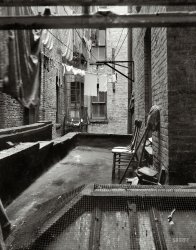
- A Very Kelly Christmas: 1940
- ... who works in the Navy yard in South Boston. Their present tenement in Quincy is completely inadequate. They have been unable to move ... mom.
Completely inadequate Inadequate though this tenement may be deemed to be, it’s still a far cry from some of the lodgings ... Posted by Dave - 11/16/2018 - 5:35pm -
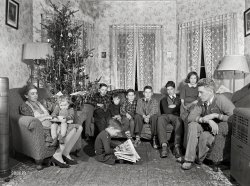
- Sal's Italian Groceries: 1936
- December 1936. "Scene from the Bronx tenement district from which many of the New Jersey homesteaders have come." ... Posted by Dave - 02/07/2013 - 10:47am -
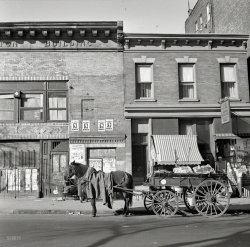
- Hung Out to Dry: 1936
- December 1936. "New York. Scene from the Bronx tenement district from which many of the New Jersey homesteaders have come." ... Posted by Dave - 03/29/2013 - 12:35pm -
![Hung Out to Dry: 1936 December 1936. "New York. Scene from the Bronx tenement district from which many of the New Jersey homesteaders have come." There are a million stories in the Naked City, and a lot of them seem to involve laundry. Photo by Arthur Rothstein for the Resettlement Administration. View full size.
Fishing in the BronxI assume those are not fishing or flag poles on about every rooftop.
Does anyone know what they are for or their purpose?
Rear Window?If this image had been shot at night, I would half expect to see the glow of Lars Thorwald's lit cigarette in one of those darkened windows.
Radio AntennasMy aunt & grandmother lived in the LaReine apartments on Connecticut Ave, Washington, very near Chevy Chase Circle [built very late 1920s]. Each apartment had its own ++AM++ antenna on the roof with a cable to an outlet in the living room. There were frames on the roof with the antennas strung between them, as in this Shorpy photo.
Question from a Country BoyI understand that the larger (steel?) structures on the roof are for access by tenants, maintenance, etc. However the smaller units have doors that don't look walkable, and there seems to be an excess of them. My lifetime experience with roofs is just to shed rain and snow, so I become interested in the various uses on the city roofs.
Window BoxWhat is that in the top right window? And what's with the pillows stuffed in the window just to the left of that?
Re:Window BoxThe box is called a 'pie safe.' It's designed to let baked goods cool without them being swiped by pigeons, gulls, or boys.
If you look closely you can see perforations in it.
The pillows are probably being aired out. I wonder how often they had to be retrieved from the back yard.
As to the small doors on the boxes next to the chimneys I think those are trash chutes that lead to the ground or to a bin next to the furnace where they were incinerated.
Advantages of 4th floorI assume that the people on the fourth floor had dibs on the clothesline on the roof. In return for having to walk up all those flight of stairs, they never had to retrieve their bloomers from the lawn because one of the clothespins broke!
PolesWhat are all those poles for? Radio?
(The Gallery, Arthur Rothstein, NYC)](https://www.shorpy.com/files/images/SHORPY_8b28411a.thumbnail.jpg)
- Condemned: 1939
- ... of public housing projects as the modern equivalent of tenement housing. Think of what an improvement a housing project would have ... Posted by Dave - 08/30/2012 - 11:04am -
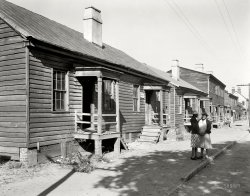
- Today's Tom Sawyer: 1940
- ... "newsies," the children of the migrant farmers, and the tenement dwellers and keep thinking of my own little boy, who at 4 1/2 would, ... Posted by Dave - 01/04/2008 - 9:41am -
![Today's Tom Sawyer: 1940 Making his third appearance here in as many days, the impish Iowa farmboy captured on film by John Vachon in May 1940. View full size.
Dee Dee Do DoHe looks as though he stepped out of a Twilight Zone episode. Maybe Billy Mumy sent himself to the cornfield.
No his mind is not for rentExactly what I was thinking!! hahaha
A Little Boy's PocketsI'll bet he has a frog in one pocket and marbles in the other.
My New Favorite BlogMy goodness, I just can't get enough of this blog. I snuck peeks all day while "working." It's the images from Hine that have spoken to me the most. I look at the faces of the children in the mills, the "newsies," the children of the migrant farmers, and the tenement dwellers and keep thinking of my own little boy, who at 4 1/2 would, perhaps, be out working in these same conditions if it were a hundred years ago. I just can't put my head around that. And yet I look at this impish, freckle-faced guy staring out at me from 68 years ago and he looks so much like my little guy who likes to play Gameboy while lounging in his Spiderman PJs.
Thank you for reminding me how fortunate we were to have had these people as our ancestors. We forget them so quickly but a blog like this -- something they couldn't have ever imagined! -- lets them live on.
[Wow. Thanks, Tricia. - Dave]
Best. Caption. Ever!.
He gets high on you...and the space he invades he gets by on you.
Dave, did you just drop a Rush lyric on a Shorpy pic?
Wow.
The KidGave him a thumbs up and added it to Stumble!
(The Gallery, John Vachon, Kids, Rural America)](https://www.shorpy.com/files/images/8a06086u3.thumbnail.jpg)
- The Indy Five: 1908
- ... photographs by Lewis Wickes Hines in this period. Every tenement apartment is filthy, every parent of a child worker shown is ... Posted by Dave - 08/15/2012 - 9:27am -
![The Indy Five: 1908 August 1908. "Noon hour in an Indianapolis furniture factory. Witness, E.N. Clopper." View full size. Photo and caption by Lewis Wickes Hine.
Just wonderingI've been looking at your blog for a while now and I was just wondering, was anyone ever happy before 1941?
It's rareNotsotricky, it is rare to find a smiling face in photographs by Lewis Wickes Hines in this period. Every tenement apartment is filthy, every parent of a child worker shown is neglectful and usually a drunkard, and every child labourer has the stare of someone who has seen too much war.
SmilesHave a look at Indiana Janes
Not necessarily traditional to smileIt's far from frequent to see smiling faces in any portraits of the period. Photography was still a serious business for people; even in portraits of that time it was far from obligatory to smile.
Say CheeseHow fast were the films or plates that these photographers used? I'd always heard that folks tended not to smile because it was tough to hold it convincingly for long enough to make the exposure. Any truth to that?
[Probably more true for the days of the daguerreotype in the 19th century, when chairs in portrait studios had neck braces to keep the subjects' heads from moving. Lewis Hine, in the captions he wrote for these photographs, noted that his younger subjects often tended to be wary, worried that they might get in trouble with bosses or parents, or lose their jobs. - Dave]
(The Gallery, Indianapolis, Kids, Lewis Hine)](https://www.shorpy.com/files/images/01319u1.thumbnail.jpg)
- Cream City: 1936
- ... a window air conditioning unit affixed to an early 1900s tenement. A smart shorpyite informed me that it was meant to be a sort of ... Posted by Dave - 06/18/2021 - 3:30pm -
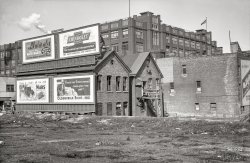
- The Boys of Mott Street: 1942
- ... of Honor Those banners would be hung vertically between tenement buildings on both sides of the street. I seem to remember that some of ... Posted by Dave - 04/24/2013 - 9:35pm -
![The Boys of Mott Street: 1942 August 1942. "Italian-American parade honoring neighborhood boys in the United States Army." A close-up of the banner glimpsed here. (The bottom, just out of the frame at right, reads WE MUST NOT FAIL THEM.) Medium-format negative by Marjory Collins for the Office of War Information. View full size.
StorefrontsHere's the view of those storefronts today, 278-280 Mott Street.
From Prince to BleeckerWhat is that all about?
[Streets. - Dave]
Mott St.Mott is a marvelous Lower East Side street, running from Worth St. in the south, where it’s Chinatown, through some remnants of Little Italy a few streets beyond Canal, morphing into trendy shops before it terminates at Bleecker, above Houston, passing St. Patrick’s Old Cathedral (actually on Mulberry) on the way.
Italian-Americans in WWIIItalian-Americans won thirteen Medals of Honor, as well as countless decorations for courage and meritorious service in WWII. My father served in the Marine Corps in WWII. He is now 100 years old, and grew up in this neighborhood, his parents having immigrated from Sicily and Southern Italy in the late 1800s. Although you didn't win any medals, Dad, you'll always be my hero!
Flags of HonorThose banners would be hung vertically between tenement buildings on both sides of the street. I seem to remember that some of them had blue stars, one each for the boys of the block that were in the service and gold stars for each serviceman that died, Somehow they kept them updated. They would be blown down occasionally but raised again. Eventually the weather wore them out. In a previous post I said that the people threw coins onto the flags as they were being carried through the streets, obviously they tossed paper money as well. I now wonder if some of that cash was used to maintain them.
Feast of San RoccoThis parade was on August 16, 1942, the day of the Feast of San Rocco in the liturgical calendar. Italian immigrants had developed a practice in the 19th century of celebrating feast days with street festivals like this. The residents of Mott Street decided to use that day to celebrate local boys who had just been inducted.
(The Gallery, Marjory Collins, NYC, Patriotic, WW2)](https://www.shorpy.com/files/images/SHORPY_8d21747u.thumbnail.jpg)
- Wise Valet: 1943
- May 1943. "New York. A tenement house in Harlem." Note the sign advising of COVER. Photo by Gordon ... Posted by Dave - 02/28/2015 - 8:47am -
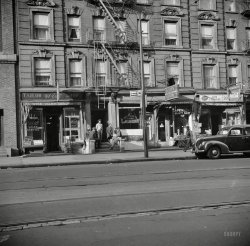
- Listen My Children: 1900
- ... the house where Henry Wadsworth Longfellow was born was a tenement occupied by Irish families.
During that period, it is said a ... Posted by Dave - 08/21/2012 - 4:51pm -
![Listen My Children: 1900 Portland, Maine, circa 1900. "Longfellow's birthplace." The home where Henry Wadsworth Longfellow was born in 1807, when Portland was part of Massachusetts. Off to the right, in front of the Block Shop: Two Shortfellows. 8x10 inch glass negative, Detroit Publishing Company. View full size.
Watch Your StepI hope there is another entrance to the place next door because that first step at the door we see is a doozy.
Blowin in the WindI like the ship weather vane.
AntennaI am not sure of its exact location but there seems to be an antenna on a roof top near the telephone pole on the right If so, what in early 1900's would it hope to receive?
[Airwaves. - Dave]
Anecdotal evidence
The house, which faced the harbor, stood on Fore Street, then a fashionable part of Portland.
In later years the house where Henry Wadsworth Longfellow was born was a tenement occupied by Irish families.
During that period, it is said a Portland schoolteacher asked her class, "Can you tell me where the poet Longfellow was born?"
A small boy answered, "Yes'm, in Patsy Connor's bedroom."
The house was torn down in 1955.
Source: Maine Memory Network
About to Fade AwayThe "Block Shop" was probably a source of rigging blocks for sailing ships, a business already in eclipse in 1900. The ship-rigged weathervane is appropriate. Not only did such ships require over 100 blocks to handle control lines, but to the people buying them, it mattered which way the wind was blowing.
Another neat detail in this photo is the corner piece of the sidewalk, which seems to be a single piece of stone with the storm drain carved into it rather than a poured concrete thing such as would be used today. New England was always well endowed with stone, especially hard-to-work granite.
161 Fore StreetIf that's the correct address, then a Residence Inn sits on this spot now. What a shame that the city didn't hold onto this piece of history.
(The Gallery, DPC)](https://www.shorpy.com/files/images/4a07997a.thumbnail.jpg)
- High Stakes: 1909
- ... do group of boys. Even with the clothesline this is not a tenement roof, but a high end building. In the Park and 5th Avenue buildings, ... Posted by Dave - 04/19/2014 - 2:27pm -
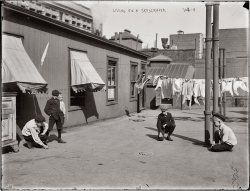
- Kids in the Hall: 1940
- ... January 1940. "Tenants living in a crackerbox. Slum tenement in Beaver Falls, Pennsylvania." Medium format negative by Jack Delano. ... as a small, single family type home. This appears to be a tenement building of some sort.
[As stated in the caption. - Dave]
... Posted by Dave - 11/08/2018 - 10:42am -
![Kids in the Hall: 1940 January 1940. "Tenants living in a crackerbox. Slum tenement in Beaver Falls, Pennsylvania." Medium format negative by Jack Delano. View full size.
CrackerboxInteresting - I don't know the nuances of the term and it's not widely used in my experience, but I always thought of a crackerbox as a small, single family type home. This appears to be a tenement building of some sort.
[As stated in the caption. - Dave]
Yes but those are contradictory terms to my understanding.
Far from Broadway Beaver Falls, Joe Namath's hometown.
Bad landlordOwners, or even renters with a good landlord, would have swept away those cobwebs and swept the floor.
I am also always stunned by the beauty of tenements. Yes, they were deathtraps, yes, they were tiny and disease ridden, but by golly, they knew how to do woodwork around that plaster.
Icebox in the HallI have one EXACTLY like that sitting out in the garage.
ZappCan't quite figure out what the collection of overhead wiring is all about, but I wonder if it has anything to do with the dark fan-like marks where the wall meets the ceiling.
[You are looking at cobwebs and clotheslines. - Dave]
Head slap: Of course, me bad.
(The Gallery, Jack Delano, Kids)](https://www.shorpy.com/files/images/SHORPY-8c04420a.thumbnail.jpg)
- The Pecans of Wrath: 1911
- ... 1911. "3:30 P.M. -- Picking nuts in dirty basement tenement, 143 Hudson Street, New York. The dirtiest imaginable children were ... Posted by Dave - 12/13/2017 - 6:56am -
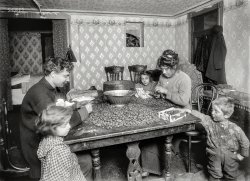
- Where the Bogs Are: 1911
- September 1911. "Crowded tenement used by cranberry pickers ('Bravas' or 'black Portuguese,' from the ... we see replicated many of the conditions of an inner-city tenement block in what otherwise was probably a very bucolic setting.
(The ... Posted by Dave - 05/06/2016 - 10:11am -
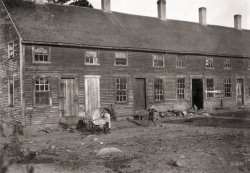
- The Signpost Up a Head: 1927
- Fredericksburg, Va., circa 1927. "Tenement, 203 Charlotte St., residence of 'Governor Hill.' Photo taken on ... kind of neighborhood we have here, as if the state of the tenement did not. One hopes that advancing age has deprived the "Governor" and ... Posted by Dave - 05/15/2016 - 12:51pm -
![The Signpost Up a Head: 1927 Fredericksburg, Va., circa 1927. "Tenement, 203 Charlotte St., residence of 'Gover­nor Hill.' Photo taken on commission from Mrs. Devore of Chatham." Note the head-on-a-pike signage. Photo by Frances Benjamin Johnston. View full size.
Stockyards Make Poor NeighborsThe sign on the left gives us a barely discernible hint as to what kind of neighborhood we have here, as if the state of the tenement did not. One hopes that advancing age has deprived the "Governor" and his first lady of their olfactory senses.
[???? - Dave]
Well HelloDolly.
GaitersDespite the obvious poverty, the gentleman is wearing a fine pair of gaiters over his pants and shoes. Too bad such a practical fashion went out of style.
(The Gallery, F.B. Johnston)](https://www.shorpy.com/files/images/SHORPY-05918a.thumbnail.jpg)
- The Libertines: 1911
- ... 6 years; Millie, 9 years, picking nuts in the basement tenement, 143 Hudson Street. Mary was standing in the open mouth of the bag ... Posted by Dave - 12/13/2017 - 12:10am -
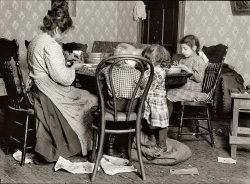
- Phipps Garden: 1940
- ... space would cure many of the social ills associated with tenement life. Whether or not that experiment succeeded or not is hard to say, ... Henry Phipps (1839-1930) grew up poor in a Pittsburgh tenement and became a friend of a neighbor, the Scottish immigrant, Andrew ... Posted by Dave - 05/10/2014 - 10:04am -
![Phipps Garden: 1940 May 17, 1940. "Phipps Garden Apartments, 5101 39th Avenue, Long Island City, New York. Clarence S. Stein, architect." Hanging with a big girl whose feet touch the ground. Large-format negative by Gottscho-Schleisner. View full size.
An early housing experimentPhipps Gardens is still a desirable development after all these years. It's owned and managed by a nonprofit corporation, with apartments made available at affordable rents to people who meet income guidelines. The concept is similar to the neighboring and larger Sunnyside Gardens, though the latter development is a cooperative rather than rentals. Both developments were inspired by the English "Garden City" movement and built by a corporation headed by various dignitaries including Eleanor Roosevelt. The idea was that providing working-class people with (relatively) low density housing that included ample open space would cure many of the social ills associated with tenement life. Whether or not that experiment succeeded or not is hard to say, but given that the developments remain quite nice today a qualified "yes" may be in order.
The photo's caption notwithstanding, Phipps Garden is not in Long Island City. As the name of its neighbor Sunnyside Gardens suggests, it's in the Sunnyside neighborhood. While Long Island City has gotten a bigger influx of affluent people who work in Manhattan, Sunnyside is a desirable neighborhood itself with its tree-lined streets and a bit of a small town feel. In the 1940's and 1950's it was known as New York's nursery on account of the high birthrate among the young families living in the area.
Current view of Phipps Garden:
View Larger Map
BenefactorHenry Phipps (1839-1930) grew up poor in a Pittsburgh tenement and became a friend of a neighbor, the Scottish immigrant, Andrew Carnegie. He worked for Carnegie as a bookkeeper. Carnegie Steel was merged with the steel companies controlled by another Robber Baron, Henry Clay Frick in 1901. Phipps part of the deal earned him $69.5 million, worth today, just slightly south of 2 Billion. His family Bank, the Bessemer Trust, controlled now by his Great Grandson, Stuart S. Janney III, was able to increase the net worth many times. Phipps became a Philanthropist building affordable housing for NYC Working People. Thousand of housing units have been built over those years, including those in today's Blog. Attached is a shot of Henry Phipps Plaza in the Kips Bay Section of Manhattan.
HeyHula Hoops weren't invented till the 60's, what is that?
[Wham-O's hula hoop dates from 1958, but hoop rolling has been around for centuries. -tterrace]
Sunnyside/Astoria/Long Island CityPhipps is in zip 11104; the post office's preferred designation is Sunnyside, but Long Island City and Astoria are also acceptable for parts of the zip. For a while in college I was a Fuller Brush salesman in this general area. Lots of 4-6 story walkups. I didn't last too long.
(The Gallery, Gottscho-Schleisner, Kids, NYC)](https://www.shorpy.com/files/images/SHORPY-5a05074u.thumbnail.jpg)
- Junk Men: 1941
- ... seen in Google streetview as the last remaining red brick tenement building on a nice-ish block in Chelsea, not far from the meatpacking ... Posted by Dave - 08/17/2020 - 2:33pm -
![Junk Men: 1941 December 1941. "Junk men with waste paper. New York City." Medium format acetate negative by Arthur Rothstein for the Farm Security Administration. View full size.
A Junk Shop for Junk Men?Perhaps there is a '4' obscured by the cart wheel (preceding the '59'). This, because at 459 W 18th Street in those days there was a Junk Shop.
Mickey's home todayIf I'm correct in reading Mickey's address as 159 West 18th Street, it can be seen in Google streetview as the last remaining red brick tenement building on a nice-ish block in Chelsea, not far from the meatpacking district.
[There is no "1." The address is just two digits. - Dave]
ColumnarHigh paid metals rags. Prices for paper.
Not so fast, Buster!How'd these rocks get under here?!
(The Gallery, Arthur Rothstein, NYC)](https://www.shorpy.com/files/images/SHORPY-8b16093a.thumbnail.jpg)
- Tiny Seamstress: 1924
- March 1924. "Tenement homework. Pictures taken in connection with investigation (see ... Posted by Dave - 03/03/2014 - 4:05pm -
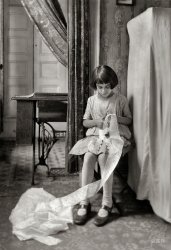
- Annie: 1912
- August 1912. Tenement home work (piecework for garment makers). "Annie Fedele, 22 Horace ... Posted by Dave - 12/10/2007 - 3:11pm -
![Annie: 1912 August 1912. Tenement home work (piecework for garment makers). "Annie Fedele, 22 Horace Street, Somerville, Massachusetts. This is one of the places she works on crochet." View full size. Photo and caption by Lewis Wickes Hine.
22 Horace StreetThe online database for Somerville's assessors includes a current photo of 22 Horace Street, as well as other buildings in that city.
The Assessors' database says the 2-family house was built in 1900, so it's probably the same building, although I can't seem to match them up. Take a look yourself by following this link -- http://data.visionappraisal.com/somervillema/search.asp
[That's interesting. Hine's caption is saying Annie lived at 22 Horace Street, not that this is necessarily the house at that address. - Dave]
PieceworkWhat kind of quality work could a young child like this do? Was it only the poorest of the poor whose children had to work? Most people who knew about these times are long gone now.
[These were mostly families that had recently immigrated from Russia, Ireland, Italy and Eastern Europe. - Dave]
(The Gallery, Kids, Lewis Hine)](https://www.shorpy.com/files/images/04256u.thumbnail.jpg)
- Blankets Fluffed: 1936
- ... income groups. Across the street from Mrs. Hochfield's tenement. Washington Avenue, Bronx, New York." Photo by Arthur Rothstein for ... Posted by Dave - 06/23/2018 - 2:13pm -
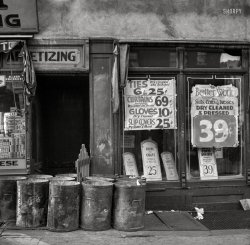
- Urban Eden: 1908
- ... They would normally be installed by the customer or the tenement handyman. Using Scotch Tape and chewing gum with the upper sash ... Posted by Dave - 04/19/2014 - 3:27pm -
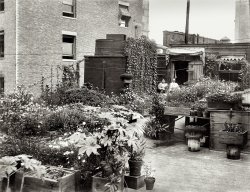
- Coal Wagon: 1928
- ... dump mechanism and sliding the coal down a ramp into the tenement's coal chute. I think it took about a half hour or so to complete the ... Posted by Dave - 10/26/2013 - 12:29pm -
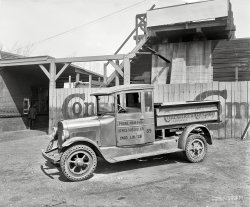
- Open Wide: 1908
- ... so equipped. My parents lived in an old five story N. Y. tenement apt. in the early 1930's and even though they got a 3rd floor apt., ... Posted by Dave - 07/24/2013 - 9:36am -
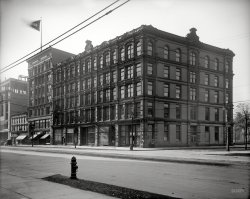
- Washday Rigging: 1905
- New York circa 1905. "Tenement courtyard." Rear Window: The Prequel. 8x10 inch dry plate glass ... Posted by Dave - 06/15/2015 - 11:11am -
